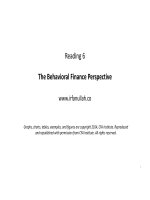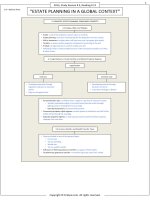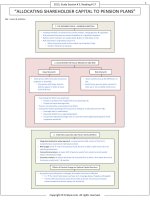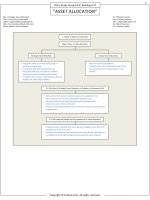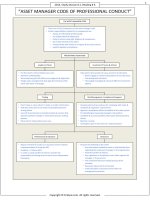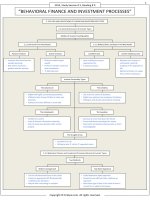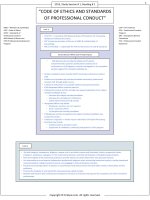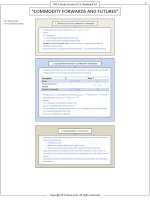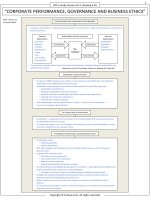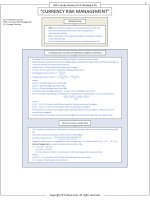FinQuiz smart summary, the behavioral finance perspective
Bạn đang xem bản rút gọn của tài liệu. Xem và tải ngay bản đầy đủ của tài liệu tại đây (554.98 KB, 7 trang )
1
2013, Study Session # 3, Reading # 7
“THE BEHAVIORAL FINANCE PERSPECTIVE”
REM = Rational Economic Man
1. INTRODUCTION
2. BEHAVIORAL VERSUS TRADITIONAL PERSPECTIVES
Traditional VS Behavioral Finance
Traditional Finance
Behavioral Finance
Grounded in neoclassical economics.
Individuals are assumed to be
rational, risk averse & utility
maximizers.
Traditional finance believes in EMH.
Grounded in psychology.
Based on observed financial behavior
rather than idealized financial
behavior.
Classification
Behavioral Finance Micro
Describe decision making process of
individuals.
Cognitive errors & emotional biases.
2.1 Traditional Finance Perspectives on Individual Behavior
Traditional finance assumes:
Investors are risk averse & self interested.
Investors make decisions based on utility theory &
revise expectations consistent with Bayes’ formula.
Efficient Markets.
2.1.1 Utility Theory and Bayes’ Formula
People maximize the PV of expected utility subject to their budget constraints.
Expected utility = weighted sum of the utility values of outcomes × Probabilities.
A rational investor make decision based on following axioms of utility theory:
Completeness ⇒ individual has well defined preferences & can decide b/w two alternatives.
Transitivity ⇒ individual decides consistently.
Independence ⇒ utilities are additive & divisible.
Continuity ⇒ ICs are smooth & unbroken (continuous).
Bayes’ formula:
New information is assumed to update beliefs about probabilities according to Bayes’ formula.
Application of conditional probability.
Assumes that events are mutually exclusive & exhaustive with known probabilities.
ܲሺܣ⁄ ܤሻ = ቂ
ሺ⁄ሻ
ሺሻ
ቃ ܲሺܣሻ
Where P (A/B) & (P (B/A)) = conditional probability of event A, (B) given B, (A).
P (B) = prior probability of event B.
P (A) = prior probability of event A.
Copyright © FinQuiz.com. All rights reserved.
Behavioral Finance Macro
Consider anomalies that distinguish
market from efficient markets.
2
2013, Study Session # 3, Reading # 7
2.1.2 Rational Economic Man
REM:
Maximize utility given budget constraints & available information.
Selfishly seek the personal utility maximizing decision.
Tries to minimize economic cost.
Govern by perfect rationality, perfect self-interest & perfect
information principles.
2.1.3 Perfect Rationality, Self-Interest, & Information
Prefect rationality ⇒ REM is a rational thinker (ability to reason & make
beneficial judgments).
Prefect self interest ⇒ REM is perfectly selfish.
Perfect information ⇒ REM has perfect knowledge of every subject.
2.1.4 Risk Aversion
Risk Attitudes
Risk Averse
Risk Neutral
Investors who prefer a certain
alternative over an uncertain one
(same expected value).
Diminishing marginal utility of
wealth (concave utility function).
Investors are indifferent b/w a
certain & uncertain alternative.
Constant marginal utility of wealth.
Linear utility function.
Risk Seeking
Investors who prefer to invest in
uncertain alternatives.
Increasing marginal utility of wealth
(convex function).
Expected utility theory assumes that investors are risk averse
(utility functions are concave & diminishing marginal utility of
wealth).
Certainty equivalent ⇒ max sum of money a person would pay
to participate or minimum amount of money a person would
accept to not participate in an event with uncertain outcome.
2.2 Behavioral Finance Perspectives on Individual Behavior
Behavioral finance challenges assumptions of traditional finance
on the following grounds:
Investors may be unable to make decisions based on utility
theory & revise expectations consistent with the Bayes’
formula.
Perfect rationality, self interest & prefect information
principles’ violation.
2.2.1 Challenges to Rational Economic Man
Bounded rationality ⇒ individual’s choices are subject to
knowledge & cognitive limitations.
REM ignores the fact that people can have difficulty prioritizing
short term v/s long term goals.
Copyright © FinQuiz.com. All rights reserved.
2013, Study Session # 3, Reading # 7
2.2.2 Utility Maximization and Counterpoint
An IC depicts all possible combination of two goods amongst which an individual
is indifferent.
For perfect substitutes (complements), the IC is a line with constant slope (Lshaped).
IC analysis fails to consider exogenous factors (e.g. risk aversion, individual’s
circumstances etc).
2.2.3 Attitudes toward Risk
Risk evaluation depends on the:
Wealth level
Circumstances of the decision maker.
Double inflection utility function ⇒ utility function that changes based on level of
wealth.
Investors are risk averse at & income levels.
Investors are risk seeking at moderate income levels.
Prospect theory ⇒ Shape of a decision maker’s value function differs for G&L.
Value function is normally concave for gains, convex for losses & steeper for
losses than for gains.
2.3 Neuro-economics
Explain how humans make economic decisions under uncertainty.
Neuro-economics explains:
Overconfidence & market overreaction.
A panicked rather than analytical response after falling market.
3. DECISION MAKING
Prospect theory & bounded rationality are based on how people do behave & make
decisions (behavioral finance based).
Expected utility & decision theories are based on how people should & make decisions
(traditional finance based).
3.1 Decision Theory
Indentify values, probabilities & other uncertainties relevant to a decision & using that
information to arrive at a theoretically optimal decision.
Based on expected value & traditional finance assumptions.
Expected utility can vary from person to person (based on the worth assigned by the
decision maker).
Expected value is same for every one (based on price).
3.2 Bounded Rationality
Subjective expected utility theory ⇒ probability distributions of all relevant variables can be provided by the decision makers.
Bounded rationality & satisfice ⇒ situation where people gather some available information, use heuristics to analyze the
information & stop at a satisfactory decision.
Satisficing ⇒ finding an acceptable solution as opposed to optimizing.
Investor takes steps to achieve intermediate goals, as long as they advance the investor towards the desired goals.
Copyright © FinQuiz.com. All rights reserved.
3
4
2013, Study Session # 3, Reading # 7
3.3 Prospect Theory
Investors analyze risk relative to possible gains & losses rather
than relative to expected return.
Investors are more concerned with the change in wealth &
place greater value on a loss than on a gain of same amount.
Phases to Making a Choice
Editing Phase
3.3.1 Evaluation Phase
Prospects are framed as gains or losses
using heuristics.
Steps in Editing
Codification
Investors identify & code outcomes as
gains or losses & assign a probability to
each.
People compute a value function based on potential outcomes
& their probabilities.
ܷ = ܹሺܲଵ ሻܸሺܺଵ ሻ + ܹሺܲଶ ሻܸሺܺଶ ሻ
Where
ܺଵ , ܺଶ = Potential outcomes
ܲଵ , ܲଶ = Probabilities
W = Probability weighting function.
The value function states:
People overreact (underreact) small (mid-sized & large)
probabilities events.
People are loss averse.
Preferences are determined by attitudes towards gains &
losses.
Combination
Investor combines those outcomes with
identical value.
Segregation
The riskless component of any prospect
is separated from its risky component.
Cancellation
Identical outcomes b/w choices can be
eliminated.
Simplification
Investors will tend not to think in precise
numbers (rounded off the prospects).
Detection of Dominance
Investor will eliminate any choice that is
strictly dominated by another.
Isolation effect ⇒ investors focus on one factor or
outcome while eliminating or ignoring others.
Copyright © FinQuiz.com. All rights reserved.
5
2013, Study Session # 3, Reading # 7
4. PERSPECTIVES ON MARKET BEHAVIOR AND PORTFOLIO CONSTRUCTION
4.1 Traditional Perspectives on Market Behavior
Traditional finance assumes EMH
4.1.1 Review of the Efficient Market Hypothesis
EMH assumes:
Market participants are REM.
Population updates its expectations as new
relevant information appears.
Relevant information is freely available to
all participants.
Forms of Market Efficiency
Weak Form
Semi-Stage Form
Consistently excess return is not
possible using technical analysis.
Reflect all historical price & volume
data.
Strong Form
All publically available information
is fully reflected in securities prices.
Excess return on continuous basis is
not possible using technical &
fundamental analysis.
All public & private information is
fully reflected in securities prices.
Even insiders are unable to
generate excess return on
consistent basis.
Grossman-Stiglitz paradox ⇒ returns to information
acquisition otherwise the market can’t be efficient.
4.1.2 Studies in Support of the EMH
4.1.2.1 Support for the Weak Form of the EMH
Test whether security prices are serially correlated or
whether they are random.
Studies conclude that security prices are random,
(support weak form of the EMH).
4.1.2.2 Support for the Semi-Strong Form of the EMH
Event studies.
Announcement of the event (not event itself) appear
to be reflected in prices.
4.1.3 Studies Challenging the EMH: Anomalies
4.1.3.1 Fundamental Anomalies
Investor generates excess return based on some
fundamental characteristic of the firm.
Small cap firms appear to outperform
large cap firms.
Growth stocks appear to outperform value
stocks.
4.1.3.2 Technical
Moving average ⇒ if the short (long) moving
avg prices rise above the long (short) avg prices,
this is an indication of strength (weakness).
Resistance level ⇒ price will climb to the
resistance level & then reverse direction (act
like a ceiling).
Support level ⇒ floor price (price will move
upward after support level reached).
Copyright © FinQuiz.com. All rights reserved.
2013, Study Session # 3, Reading # 7
4.1.3 Studies Challenging the EMH: Anomalies
4.1.3.3 Calendar Anomalies
4.1.3.4 Anomalies: Conclusion
January effect ⇒ stocks deliver abnormally
returns during the month of January.
Turn-of-the month effect ⇒ stocks earn
returns on the last day & 1st four days of each
month.
Markets are neither perfectly efficient not
completely anomalous.
4.1.3.5 Limits to Arbitrage
Uncertain need for liquidity limits the ability of
arbitrage to force prices to their intrinsic values.
Implicit in the limit to the arbitrage idea is that the
EMH does not hold.
4.2 Traditional Perspectives on Portfolio Construction
Rational portfolio:
Meets investor’s objective & constraints.
Choose from mean-variance efficient portfolios.
4.3 Alternative Models of Market Behavior and Portfolio
Construction
4.3.1 A Behavioral Approach to Consumption and Savings
Behavioral life-cycle theory incorporates:
Self control bias ⇒ short-term satisfaction to the determent of long-term goals.
Mental accounting ⇒ people ignore the fact that wealth is fungible (interchangeable) & assign different
portions of their wealth to meet different goals.
Framing bias ⇒people tend to frame their expenditure decisions (1st spend current income then spend
based on current assets & finally spend based on future income).
4.3.2 A Behavioral Approach to Asset Pricing
Behavioral assets pricing model adds a sentiment premium (stochastic discount factor) to discount rate.
Required return on an asset = Rf + fundamental risk premium + sentiment premium.
Sentiment premium ⇒ based on analysts’ forecasts.
The dispersion of analysts’ forecasts, the sentiment premium, the discount rate & the
perceived value of the assets.
4.3.3 Behavioral Portfolio Theory
Uses of probability-weighting function rather than the real probability distribution.
Investor’s structure their portfolio in layers & composition of each layer is
determined by interaction of following five factors.
The importance of the goals.
Required return.
The investor’s utility function.
Access to information.
Loss aversion.
Optimal portfolio ⇒ combination of riskless & highly speculative assets (may not
be mean-variance efficient).
Copyright © FinQuiz.com. All rights reserved.
6
2013, Study Session # 3, Reading # 7
4.3.4 Adaptive Markets Hypothesis
Revised version of the EMH that considers bounded rationality, Satisficing &
evolutionary principles.
The competition & adaptable the participants, the likelihood of not
surviving.
Five implications:
Risk premiums change over time.
Active management can add value.
Consistent outperformance is impossible.
Investors must adapt to survive.
Survival is the essential objective.
Copyright © FinQuiz.com. All rights reserved.
7
